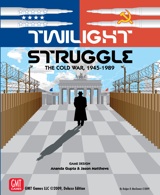Twilight Struggle: The Cold War, 1945-1989 – Boardgame Review
 Twilight Struggle: The Cold War, 1945-1989 – Deluxe Edition. GMT Games LLC $54.99
Twilight Struggle: The Cold War, 1945-1989 – Deluxe Edition. GMT Games LLC $54.99
Passed Inspection: Interesting, evocative treatment of a critical period in modern history. One of the best card-driven strategy games available, with appeal that reaches well beyond traditional war games. The components have been upgraded, while the new optional rules and cards are interesting and for the most part add to play value without much increase in complexity.
Failed Inspection: The new optional event cards have some errata as written, and even with the additions, some of the "gameiness" remains. Finally, the revamped game board might not appeal to everyone.
What cards you have in your hand and when you must play them can make a huge difference in your overall strategy.
When is a war game not a war game? When the historical conflict being simulated is not a "real" war, at least not in the classic sense. Long-time publisher GMT is noted for its lineup of so-called "card-driven" war games, in which the historic events that occurred in a particular conflict are as important as the battles and campaigns themselves.
{default}Such an approach is particularly well-suited to Twilight Struggle: The Cold War 1945-1989-Deluxe Edition, which paints a vivid picture of the more than four decades of political-and sometimes military-maneuvering of the US and Soviet superpowers and their various allies. The stars of the game are the cards, which generally follow the same pattern as every game in this genre.
Each player alternates playing a card for his action phase, and each turn has a certain number of action phases (generally 6 or 7) until the turn is over. A card may be played for operations points, which vary from a low of 1 to a high of 4 per card. Operations allow each player in turn to: place influence, attempting to swing countries over to the US or Soviet side; try and "re-align" an area and kick the opposing player out; or perform a coup. The latter is the most war-game-like thing in Twilight Struggle, as it involves rolling dice. Depending on the outcome, it could end with you controlling a key country for several turns to come or with a failed coup, leaving an opening for your opponent to exploit.
Alternatively, each card may be played for an event, all of which are taken from the myriad strategies, campaigns, covert missions, and personalities that made up the Cold War. We find Khrushchev banging his shoe for the "We will destroy you" event, countered by JFK’s "Ask not what your country can do for you … ." and so on. The Korean War, the peace movement of the 60s, NATO vs. Warsaw Pact, the "Evil Empire," Nixon goes to China-it’s all here, in a format that both enlightens and illuminates the era, but also lets you see how things might have turned out very differently, captured in a most entertaining package.
In Twilight Struggle, each player must play a card every action round. If you play a card for operations that has an event that benefits your opponent, he gets that event for free-even though it is your turn. This makes the game more historical, as more events actually occur in the game, and this also makes every game of Twilight Struggle unique. What cards you have in your hand and when you must play them can make a huge difference in your overall strategy.
[continued on next page]
Pages: 1 2


Nice review! I’m glad to see one of my favorite new games getting coverage. I may be mistaken, but it appears to me that there are at least 3 errors in this review:
1. Coups are not the only “wargame†like thing resolved by die roll. Realignments, the Olympics, war cards (Korean War, Indo-Pakistani War, Brush War, etc.), and others are also resolved with a die – in the case of realignments and the Olympics, with a competitive die roll.
2. Failing a coup attempt does not create an opening for your opponent to exploit – you just wasted your efforts for a “no effect.â€
3. There is no “North America†score card. It is a “Central America†score card.
I saw some people playing this game a few months ago. Looked really fun!